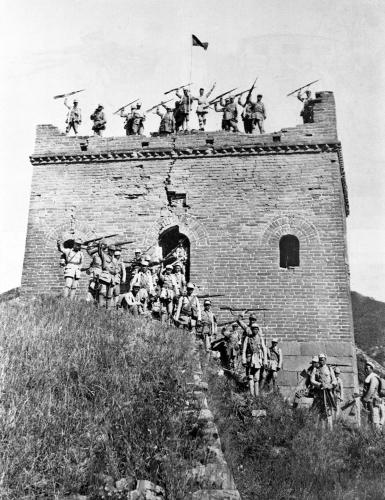|
 |
|
CHEERING THE VICTORY: Soldiers of the Eighth Route Army led by the Communist Party of China celebrate their victory over the Japanese army in Laiyuan, Hebei Province, during the Hundred Regiment Campaign in 1940 (XINHUA) |
Although the Japanese quickly captured all key Chinese ports and industrial centers, the combined KMT and CPC forces continued to resist them.
In the conflict, the Japanese forces committed many massacres and atrocities, most infamously in Nanjing in December 1937, when Japanese troops slaughtered an estimated 300,000 civilians. Warfare of this nature led, by the war's end, to an estimated 10 million to 20 million Chinese civilian deaths.
By 1940, the war had descended into a stalemate. The Japanese seemed unable to force victory, nor the Chinese to evict the Japanese troops.
"The Chinese battlefield made a great contribution to the whole anti-fascist war around the world. Without the tenacious resistance by the Chinese people, the strategic situation would have been far more favorable for the German-Italian-Japanese fascist bloc when WWII broke out full-scale in 1939," Peng said.
Until the Pearl Harbor Incident in 1941, the Chinese fought the Japanese armies practically alone. "During this time, a poor and underdeveloped country held down some 800,000 troops from one of the most highly militarized and technologically advanced societies in the world," said Rana Mitter, a professor of the history and politics of modern China at the University of Oxford in Britain.
In July 1938 and again from May to August in 1939, the Japanese army division in northeast China assaulted the Soviet army. In both attacks, the Japanese failed, largely because a large portion of its forces was engaged in fighting in other parts of China.
On August 20, 1940, the troops under CPC leadership launched the well-known Hundred Regiment Campaign, during which the CPC forces fought a total of 1,824 large- and small-scale battles, inflicted 20,645 casualties upon the Japanese troops, destroyed major railways and highways, rooted up 2,993 strongholds of the enemy and puppet troops, and recovered 40-50 counties.
 |
|
UP IN ARMS: Japanese soldiers surrender their weapons to the Chinese army during the war (XINHUA) |
 |
|
END OF THE WAR: On September 9, 1945, He Yingqin (left), representative of the Chinese Government and the Southeast Asia Ally Forces, accepts the Japanese army's instrument of surrender in Nanjing, then China's capital (XINHUA) |
China as battlefield
The outbreak of the Pacific War in 1941 saw the Allied powers establishing a China-Burma-India theater of war, beginning January 5, 1942.
Along with Joseph Stilwell (1883-1946) as the chief of staff of the Chinese army, a group of American volunteer pilots in China, the Flying Tigers, were incorporated into the United States' 14th Air Force on July 4, 1942, with Claire Chennault (1893-1958) as commander.
During the early phases of the Pacific War, the Allied performance was poor in contrast with the Chinese resistance. Hence, former U.S. President Franklin Roosevelt (1882-1945) was determined to make China one of the Big Four.
He said, "Had China not been fighting, or had China been defeated, how many Japanese troops do you think would then be deployed to other regions to fight? They would have captured Australia and India all at once, and then pushed to the Middle East."
After the Pacific War broke out, the Chinese battlefield continued to engage most of the Japanese army, greatly boosting the strength of the United States, Britain and other countries in their war against Japan.
China inflicted heavy casualties on the Japanese, costing them 1.5 million troops, up to 70 percent of the total Japanese troops killed during WWII.
However, the Chinese people also paid dearly for this victory. Total casualties were estimated at 35 million. The direct property loss suffered by the Chinese was valued at $100 billion and the indirect property loss at $500 billion.
On November 1, 1943, the United States, Britain and the Soviet Union accepted China as one of the cosigners of the Moscow Declaration. On December 1, 1943, China, Britain and the United States jointly issued the Cairo Declaration. The Potsdam Proclamation was also jointly issued by Chinese, American and British governments on July 26, 1945, sounding the death knell for fascist warmongers worldwide.
On August 15, 1945, the war ended with the Japanese declaring unconditional surrender. The Chinese people had achieved their first anti-imperialist victory since the Opium War in 1840-42. On September 2, 1945, the Instrument of Surrender was signed on board the USS Missouri in Tokyo Bay.
After eight years of epic fighting, the Chinese people witnessed the fall of the Japanese fascist regime and embraced a new epoch in which Asia took steps toward peace.
|
